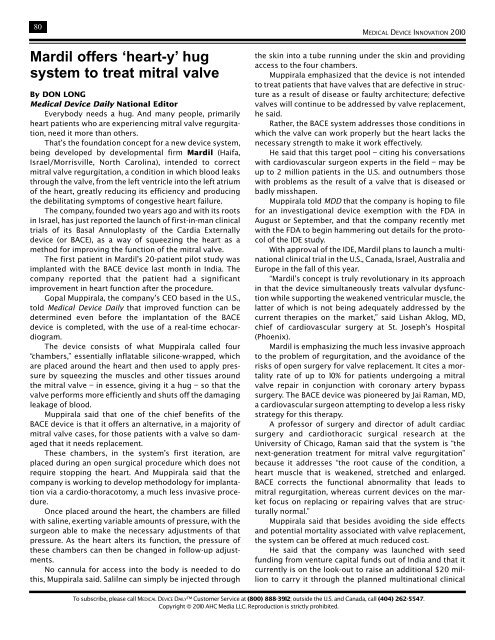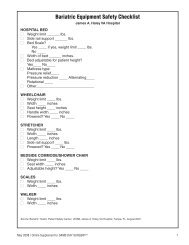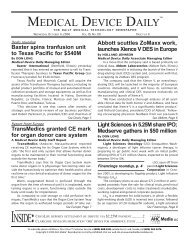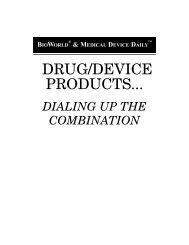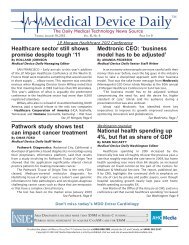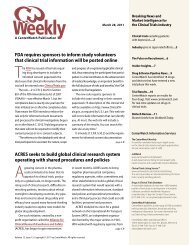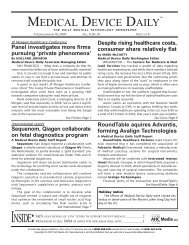MEDICAL DEVICE INNOVATION - Medical Device Daily
MEDICAL DEVICE INNOVATION - Medical Device Daily
MEDICAL DEVICE INNOVATION - Medical Device Daily
You also want an ePaper? Increase the reach of your titles
YUMPU automatically turns print PDFs into web optimized ePapers that Google loves.
80<br />
Mardil offers ‘heart-y’ hug<br />
system to treat mitral valve<br />
By DON LONG<br />
<strong>Medical</strong> <strong>Device</strong> <strong>Daily</strong> National Editor<br />
Everybody needs a hug. And many people, primarily<br />
heart patients who are experiencing mitral valve regurgitation,<br />
need it more than others.<br />
That’s the foundation concept for a new device system,<br />
being developed by developmental firm Mardil (Haifa,<br />
Israel/Morrisville, North Carolina), intended to correct<br />
mitral valve regurgitation, a condition in which blood leaks<br />
through the valve, from the left ventricle into the left atrium<br />
of the heart, greatly reducing its efficiency and producing<br />
the debilitating symptoms of congestive heart failure.<br />
The company, founded two years ago and with its roots<br />
in Israel, has just reported the launch of first-in-man clinical<br />
trials of its Basal Annuloplasty of the Cardia Externally<br />
device (or BACE), as a way of squeezing the heart as a<br />
method for improving the function of the mitral valve.<br />
The first patient in Mardil’s 20-patient pilot study was<br />
implanted with the BACE device last month in India. The<br />
company reported that the patient had a significant<br />
improvement in heart function after the procedure.<br />
Gopal Muppirala, the company’s CEO based in the U.S.,<br />
told <strong>Medical</strong> <strong>Device</strong> <strong>Daily</strong> that improved function can be<br />
determined even before the implantation of the BACE<br />
device is completed, with the use of a real-time echocardiogram.<br />
The device consists of what Muppirala called four<br />
“chambers,” essentially inflatable silicone-wrapped, which<br />
are placed around the heart and then used to apply pressure<br />
by squeezing the muscles and other tissues around<br />
the mitral valve – in essence, giving it a hug – so that the<br />
valve performs more efficiently and shuts off the damaging<br />
leakage of blood.<br />
Muppirala said that one of the chief benefits of the<br />
BACE device is that it offers an alternative, in a majority of<br />
mitral valve cases, for those patients with a valve so damaged<br />
that it needs replacement.<br />
These chambers, in the system’s first iteration, are<br />
placed during an open surgical procedure which does not<br />
require stopping the heart. And Muppirala said that the<br />
company is working to develop methodology for implantation<br />
via a cardio-thoracotomy, a much less invasive procedure.<br />
Once placed around the heart, the chambers are filled<br />
with saline, exerting variable amounts of pressure, with the<br />
surgeon able to make the necessary adjustments of that<br />
pressure. As the heart alters its function, the pressure of<br />
these chambers can then be changed in follow-up adjustments.<br />
No cannula for access into the body is needed to do<br />
this, Muppirala said. Salilne can simply be injected through<br />
<strong>MEDICAL</strong> <strong>DEVICE</strong> <strong>INNOVATION</strong> 2010<br />
the skin into a tube running under the skin and providing<br />
access to the four chambers.<br />
Muppirala emphasized that the device is not intended<br />
to treat patients that have valves that are defective in structure<br />
as a result of disease or faulty architecture; defective<br />
valves will continue to be addressed by valve replacement,<br />
he said.<br />
Rather, the BACE system addresses those conditions in<br />
which the valve can work properly but the heart lacks the<br />
necessary strength to make it work effectively.<br />
He said that this target pool – citing his conversations<br />
with cardiovascular surgeon experts in the field – may be<br />
up to 2 million patients in the U.S. and outnumbers those<br />
with problems as the result of a valve that is diseased or<br />
badly misshapen.<br />
Muppirala told MDD that the company is hoping to file<br />
for an investigational device exemption with the FDA in<br />
August or September, and that the company recently met<br />
with the FDA to begin hammering out details for the protocol<br />
of the IDE study.<br />
With approval of the IDE, Mardil plans to launch a multinational<br />
clinical trial in the U.S., Canada, Israel, Australia and<br />
Europe in the fall of this year.<br />
“Mardil’s concept is truly revolutionary in its approach<br />
in that the device simultaneously treats valvular dysfunction<br />
while supporting the weakened ventricular muscle, the<br />
latter of which is not being adequately addressed by the<br />
current therapies on the market,” said Lishan Aklog, MD,<br />
chief of cardiovascular surgery at St. Joseph’s Hospital<br />
(Phoenix).<br />
Mardil is emphasizing the much less invasive approach<br />
to the problem of regurgitation, and the avoidance of the<br />
risks of open surgery for valve replacement. It cites a mortality<br />
rate of up to 10% for patients undergoing a mitral<br />
valve repair in conjunction with coronary artery bypass<br />
surgery. The BACE device was pioneered by Jai Raman, MD,<br />
a cardiovascular surgeon attempting to develop a less risky<br />
strategy for this therapy.<br />
A professor of surgery and director of adult cardiac<br />
surgery and cardiothoracic surgical research at the<br />
University of Chicago, Raman said that the system is “the<br />
next-generation treatment for mitral valve regurgitation”<br />
because it addresses “the root cause of the condition, a<br />
heart muscle that is weakened, stretched and enlarged.<br />
BACE corrects the functional abnormality that leads to<br />
mitral regurgitation, whereas current devices on the market<br />
focus on replacing or repairing valves that are structurally<br />
normal.”<br />
Muppirala said that besides avoiding the side effects<br />
and potential mortality associated with valve replacement,<br />
the system can be offered at much reduced cost.<br />
He said that the company was launched with seed<br />
funding from venture capital funds out of India and that it<br />
currently is on the look-out to raise an additional $20 million<br />
to carry it through the planned multinational clinical<br />
To subscribe, please call <strong>MEDICAL</strong> <strong>DEVICE</strong> DAILY Customer Service at (800) 888-3912; outside the U.S. and Canada, call (404) 262-5547.<br />
Copyright © 2010 AHC Media LLC. Reproduction is strictly prohibited.


